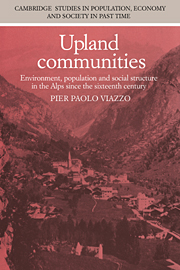 Upland Communities
Upland Communities Published online by Cambridge University Press: 13 October 2009
The Alps, ‘a magnificent laboratory’
Although Alpine anthropology has established itself only in the last few decades, it had a distinguished forerunner. In the summer of 1912 Robert Hertz, one of Durkheim's most gifted pupils, was spending his holidays in Cogne, a village in the Aosta Valley. His six-week vacation, however, soon turned into a short but industrious period of fieldwork when he became aware of the existence of an old religious tradition whose sociological features immediately intrigued him: the festival of Saint Besse, the patron saint of Cogne and of the adjacent Soana Valley, which took place every year on 8 August in a remote corner high in the mountains, at over 2,000 m of altitude. During the summer, Hertz was able to observe the pilgrimage to the saint's shrine and to attend the festival itself. In addition, he collected from the people of Cogne the local variants of the legends surrounding the saint, which shed revealing light on the web of social relationships that linked the various communities which congregated at the festival. Back in Paris, this material was supplemented by historical, philological and iconographic research. The resulting article, published in 1913, may well be seen as the first anthropological contribution to the study of the Alps.
This article clearly shows that Hertz regarded the Alps as an especially suitable terrain for the evolutionary study of society, and in particular of those ‘elementary forms of religious life’ which were at that time the central preoccupation of Durkheim and his school.
To save this book to your Kindle, first ensure [email protected] is added to your Approved Personal Document E-mail List under your Personal Document Settings on the Manage Your Content and Devices page of your Amazon account. Then enter the ‘name’ part of your Kindle email address below. Find out more about saving to your Kindle.
Note you can select to save to either the @free.kindle.com or @kindle.com variations. ‘@free.kindle.com’ emails are free but can only be saved to your device when it is connected to wi-fi. ‘@kindle.com’ emails can be delivered even when you are not connected to wi-fi, but note that service fees apply.
Find out more about the Kindle Personal Document Service.
To save content items to your account, please confirm that you agree to abide by our usage policies. If this is the first time you use this feature, you will be asked to authorise Cambridge Core to connect with your account. Find out more about saving content to Dropbox.
To save content items to your account, please confirm that you agree to abide by our usage policies. If this is the first time you use this feature, you will be asked to authorise Cambridge Core to connect with your account. Find out more about saving content to Google Drive.